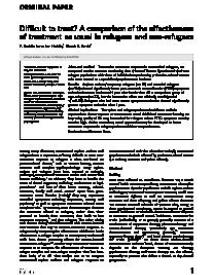Difficult to treat? : A comparison of the effectiveness of treatment as usual in refugees and non-refugees
Aims and method To examine treatment response in traumatised refugees, we compared routine outcome monitoring data (Harvard Trauma Questionnaire) of two refugee populations with those of individuals experiencing profession-related trauma who were treated at a specialised psychotrauma institute.
Results Asylum seekers/temporary refugees (n = 21) and resettled refugees (n = 169) showed significantly lower post-traumatic stress disorder (PTSD) symptom reduction between intake and 1 year after intake than did a comparison group of non-refugees (n = 37), but the interaction effect was clinically small (partial Z2 = 0.03). Refugees who had more severe symptoms at intake showed significantly greater symptom reduction after 1 year.
Clinical implications Therapists and refugee patients should have realistic expectations about response to treatment as usual. Additional treatment focusing on improving quality of life may be needed for refugees whose PTSD symptom severity remains high. At the same time, novel approaches may be developed to boost treatment response in refugee patients with low responsiveness.
Geachte bezoeker,
De informatie die u nu opvraagt, kan door psychotraumanet niet aan u worden getoond. Dit kan verschillende redenen hebben,
waarvan (bescherming van het) auteursrecht de meeste voorkomende is. Wanneer het mogelijk is om u door te verwijzen naar de bron
van deze informatie, dan ziet u hier onder een link naar die plek.
Als er geen link staat, kunt u contact opnemen met de bibliotheek,
die u verder op weg kan helpen.
Met vriendelijke groet,
Het psychotraumanet-team.
In: BJPsych Bulletin, ISSN 2056-4694 ; eISSN 2056-4708 | 39 | 4 | 182-185
http://pb.rcpsych.org/content/pbrcpsych/early/2015/05/22/pb.bp.114.047928.full.pdf


